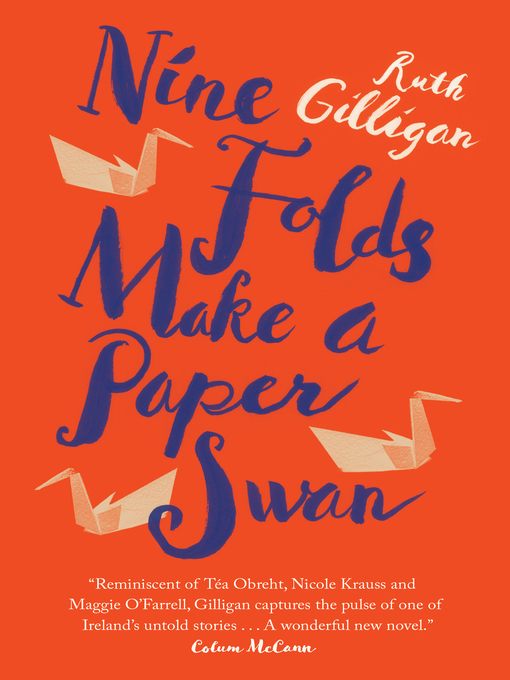
Nine Folds Make a Paper Swan
کتاب های مرتبط
- اطلاعات
- نقد و بررسی
- دیدگاه کاربران
نقد و بررسی

Starred review from October 24, 2016
Gilligan makes a stellar U.S. debut with this wistful and lyrical multigenerational tale linking the struggles of two immigrant Jewish families in Dublin with an Irish Catholic woman’s complicated relationship with her Jewish lover. The book is narrated by the three central characters: Ruth, who emigrates with her family from Lithuania in 1901 and winds up in Cork; Shem, struck mute after discovering his adored mother’s shocking secret, and then institutionalized in 1958; and Aisling, a journalist expat in London in 2011 who must decide whether to convert to Judaism to marry boyfriend Noah. These characters long for acceptance and freedom within the rigid strictures of culture and religion. Gilligan weaves a mesmerizing blend of plot and character while exploring themes of assimilation and displacement, suggesting what binds us all is storytelling; a book on Jewish conversion links Aisling and Sham, while Ruth, as a midwife, reprises her aspiring playwright father’s “forgotten ideas” and “all the little Irish snippets” of her youth. Agent: Dorian Karchmar, WME Entertainment.

Starred review from November 15, 2016
In a boldly ambitious novel of family and belonging, Gilligan chronicles the history of Jewish immigrants in Ireland by weaving together three interconnected stories spanning more than a century.It's 1901, and Ruth Greenberg has accidentally immigrated to Ireland with her family, the Lithuanians having misheard "Cork" for "New York." Her father, Moshe, joyful and tragic, is a whimsical storyteller, a would-be playwright surviving only on increasingly heartbreaking hope. Turn the page, and it's 1958, and young Shem Sweeney is in a mental institution, having stopped speaking at his own bar mitzvah, unable to utter a word since. He adores his mother with obsessive intensity, though in his silence, he can communicate with her only through flashcards. Stored away at Montague House, the flashcards are banned; instead, Shem spends his days transcribing the memories of his roommate, Alf--the only other Jew in the place--and dreaming of his mother. The novel skips forward again: it's 2011, and Aisling Creedon, an Irish journalist living in London, is on her way to celebrate Hanukkah with her Jewish boyfriend Noah's parents--a fraught occasion in its own right even before he gives her his gift. He's pale as she unwraps it: A Voyage of Discovery--Considering a Judaic Conversion?, by one Rabbi Briscoe, the only one of its kind ever printed in Ireland. The novel cycles through these stories, moving them forward, by days or by years. All three stories--more intertwined than any of the participants know--are gripping, nuanced, and clever, occupying a rich and hazy space between realism and metaphor. The novel is not entirely even--some pieces come into focus more clearly than others--but it is wholly original, challenging and tender at once. Witty and haunting, the book blurs the boundaries between past and present, between who we are and the stories we tell.
COPYRIGHT(2016) Kirkus Reviews, ALL RIGHTS RESERVED.

October 1, 2016
In Gilligan's (Forget) novel about the lives of Irish Jews, nothing is as it seems. In 1901, the boat from Lithuania carrying the Greenberg family arrives in Cork instead of New York. In the early 1950s, 13-year-old Shem Sweeney sees his beloved mother hugging and kissing a strange man and assumes she is committing adultery. He subsequently stops speaking for the rest of his life rather than defame her. In the contemporary segments, Aisling Creedon, who is considering conversion to Judaism, misinterprets what she has learned, and comes to a happier conclusion than that of the Greenbergs and Sweeneys. Throughout the book people are disappointed, fail to make their dreams come true, and run away from reality. VERDICT Although James Joyce's Leopold Bloom is one of Irish literature's most famous Jewish characters, Gilligan is in new territory examining the country's Jewish community. Slow to come together at first, her deft interweaving of three families' histories across the 20th century is replete with folk tales, jokes, and memories. She doesn't shy away from the prejudices Jews faced but creates a community that has become part of Ireland. [See "Editors' Fall Picks," LJ 9/1/16.]--Andrea Kempf, formerly with Johnson Cty. Community Coll. Lib., Overland Park, KS
Copyright 2016 Library Journal, LLC Used with permission.

January 1, 2017
Persecuted and barred from advancement in their Russian hometown, a Jewish girl and her family board a ship bound for turn-of-the-twentieth-century America, the promised land. When they find themselves in Ireland instead, they struggle to adjust, some embracing, others spurning their new home. Decades later, a young man becomes mute following a traumatic event and is committed to a mental hospital. There he finds a friend in his roommate, a Jewish war hero who needs someone to help him write down his story. And during a modern-day Christmas season, a young woman, the Catholic daughter of an Irish politician, goes home for the holidays to consider an ultimatum she was just given by her Jewish boyfriend. Each of these characters seeks to reconcile religious and national identities in a world that is formidable and sometimes hostile. In her American debut, London-based Irish writer Gilligan pieces together the largely untold story of Ireland's Jewish community, plucking at the heartstrings with this revelatory saga about hope, homeland, and perseverance.(Reprinted with permission of Booklist, copyright 2017, American Library Association.)

























دیدگاه کاربران